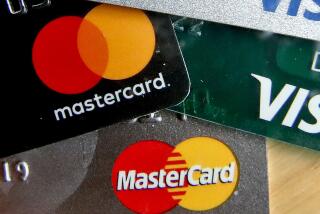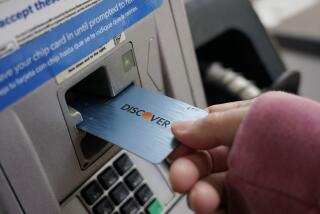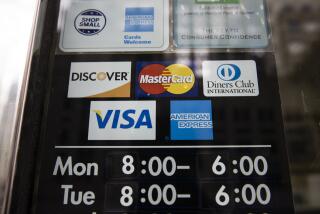Charge!
In 1914, when Western Union issued the first credit card, consumer lending was still considered somewhat sordid, the stuff of fancy-pants loan sharks and heartless finance companies attaching next yearâs alfalfa crop to pay the note on Farmer Lindquistâs new thresher.
That Americans would once shun debt now seems hilariously quaint. We buy boxer shorts on credit. Watery Bloody-Mary brunches on credit. Tickets to âFlipperâ on credit. And, when things get really out of hand--such as now, when corporate downsizing has pulled the rug out from under thousands of overextended baby boomers--we use lower-interest-rate credit cards to pay down higher-interest-rate credit cards. This is how Pan Am got into trouble, we admonish ourselves. We really ought to cool it.
We donât. Unsecured debt among Americans floated past $500 billion last year. Thatâs enough to buy a spit-shined B-2 Stealth bomber for each and every member of Congress, the president, Hillary, Chelsea, Socks and all the purchasers of Roger Clintonâs first album. That $360 billion of this humongous burden was amassed with 2 1/8-by-3 3/8-inch plastic rectangles emblazoned with centurions, holographic doves, Mercator projections of the globe and the logos of everyone from the Rolling Stones to the Sierra Club, says a lot about our faith in mastering the possibilities.
Department stores, gas companies and airlines issued credit cards in the â20 and â30s, mostly to promote brand loyalty. The game changed in 1949 with the introduction of Diners Club, the first card that could be used at a variety of establishments. Banks, led by Californiaâs Bank of America, joined the fray; by 1955 more than 100 bank credit cards were offered. In 1958, Carte Blanche and American Express entered the market, the same year that banks--itâs hard to imagine them ever doing otherwise--began charging interest on outstanding balances. By 1984, 71% of Americans between 17 and 65 carried at least one credit card. Last year, Americans used credit cards in more than 10 billion transactions worth $600 billion.
Besides the staggering debt we accrue on them--and the extortionate interest rates we blithely allow banks to charge us--credit cards have wormed their way into the very heart of our culture. We literally canât--and probably donât want to--get along without them, as anyone who has tried to use cash to rent a car, check into a hotel or even send a Federal Express package can attest. Theyâve spawned their own lexicon (âmaxed-outâ), their own trivia (Q: Whose name appears on American Express cards shown in advertisements? Is he a real person?), as well as opening up new and intriguing avenues of fraud.
With routine credit-card purchases on the Internet imminent and the arrival of so-called âsmart cards,â which can squirrel vast financial and personal data onto a cunning, thumbnail-sized microprocessor, cash is becoming irrelevant, even unseemly--the medium of exchange of last resort, the coin of the disenfranchised, criminal or eccentric. Credit cards, on the other hand, are the perfect expression of the â90s Zeitgeist: bland as a bank statement, powerful as a thunderbolt, they instantly empower and defer consequence. In an age when reality is increasingly held at bay, credit cards offer nothing more--and nothing less--than the illusion of money in the bank.
More to Read
Inside the business of entertainment
The Wide Shot brings you news, analysis and insights on everything from streaming wars to production â and what it all means for the future.
You may occasionally receive promotional content from the Los Angeles Times.










